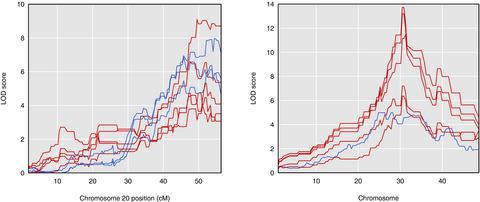当前位置:
X-MOL 学术
›
Ecol. Evol.
›
论文详情
Our official English website, www.x-mol.net, welcomes your feedback! (Note: you will need to create a separate account there.)
Clustering of loci controlling species differences in male chemical bouquets of sympatric Heliconius butterflies
Ecology and Evolution ( IF 2.6 ) Pub Date : 2020-12-16 , DOI: 10.1002/ece3.6947 Kelsey J. R. P. Byers 1, 2 , Kathy Darragh 1, 2 , Sylvia Fernanda Garza 2 , Diana Abondano Almeida 2 , Ian A. Warren 1 , Pasi M. A. Rastas 3 , Richard M. Merrill 2, 4 , Stefan Schulz 5 , W. Owen McMillan 2 , Chris D. Jiggins 1, 2
Ecology and Evolution ( IF 2.6 ) Pub Date : 2020-12-16 , DOI: 10.1002/ece3.6947 Kelsey J. R. P. Byers 1, 2 , Kathy Darragh 1, 2 , Sylvia Fernanda Garza 2 , Diana Abondano Almeida 2 , Ian A. Warren 1 , Pasi M. A. Rastas 3 , Richard M. Merrill 2, 4 , Stefan Schulz 5 , W. Owen McMillan 2 , Chris D. Jiggins 1, 2
Affiliation

|
The degree to which loci promoting reproductive isolation cluster in the genome—that is, the genetic architecture of reproductive isolation—can influence the tempo and mode of speciation. Tight linkage between these loci can facilitate speciation in the face of gene flow. Pheromones play a role in reproductive isolation in many Lepidoptera species, and the role of endogenously produced compounds as secondary metabolites decreases the likelihood of pleiotropy associated with many barrier loci. Heliconius butterflies use male sex pheromones to both court females (aphrodisiac wing pheromones) and ward off male courtship (male‐transferred antiaphrodisiac genital pheromones), and it is likely that these compounds play a role in reproductive isolation between Heliconius species. Using a set of backcross hybrids between H. melpomene and H. cydno, we investigated the genetic architecture of putative male pheromone compound production. We found a set of 40 significant quantitative trait loci (QTL) representing 33 potential pheromone compounds. QTL clustered significantly on two chromosomes, chromosome 8 for genital compounds and chromosome 20 for wing compounds, and chromosome 20 was enriched for potential pheromone biosynthesis genes. There was minimal overlap between pheromone QTL and known QTL for mate choice and color pattern. Nonetheless, we did detect linkage between a QTL for wing androconial area and optix, a color pattern locus known to play a role in reproductive isolation in these species. This tight clustering of putative pheromone loci might contribute to coincident reproductive isolating barriers, facilitating speciation despite ongoing gene flow.
中文翻译:

同胞Heliconius蝴蝶雄性化学花束中控制物种差异的基因座聚类
促进生殖分离的基因座在基因组中的集聚程度(即生殖分离的遗传结构)可以影响物种形成的速度和方式。这些基因座之间的紧密连接可以促进面对基因流的物种形成。信息素在许多鳞翅目物种的生殖分离中发挥作用,内源产生的化合物作为次生代谢物的作用降低了与许多障碍基因座相关的多效性的可能性。Heliconius蝴蝶对宫廷雌性(壮阳药翅性信息素)和男性求偶(雄性转移的抗壮阳药生殖激素信息素)都使用男性性信息素,这些化合物很可能在Heliconius之间的生殖隔离中发挥作用种类。使用一套H. melpomene和H.cydno的回交杂种,我们调查了推定的雄性信息素化合物生产的遗传结构。我们发现了代表40个潜在的信息素化合物的40个重要的定量性状基因座(QTL)。QTL在两个染色体上显着聚集,生殖器化合物的第8号染色体和机翼化合物的第20号染色体,并且20号染色体富含潜在的信息素生物合成基因。信息素QTL与已知QTL之间在配偶选择和颜色模式方面的重叠很小。尽管如此,我们确实检测到了翼雄蕊区的QTL与optix之间的联系,一种已知在这些物种的生殖隔离中起作用的颜色模式。假定的信息素基因座的这种紧密聚集可能会导致同时发生的生殖隔离障碍,尽管正在进行基因流动,但仍有助于物种形成。
更新日期:2021-01-08
中文翻译:

同胞Heliconius蝴蝶雄性化学花束中控制物种差异的基因座聚类
促进生殖分离的基因座在基因组中的集聚程度(即生殖分离的遗传结构)可以影响物种形成的速度和方式。这些基因座之间的紧密连接可以促进面对基因流的物种形成。信息素在许多鳞翅目物种的生殖分离中发挥作用,内源产生的化合物作为次生代谢物的作用降低了与许多障碍基因座相关的多效性的可能性。Heliconius蝴蝶对宫廷雌性(壮阳药翅性信息素)和男性求偶(雄性转移的抗壮阳药生殖激素信息素)都使用男性性信息素,这些化合物很可能在Heliconius之间的生殖隔离中发挥作用种类。使用一套H. melpomene和H.cydno的回交杂种,我们调查了推定的雄性信息素化合物生产的遗传结构。我们发现了代表40个潜在的信息素化合物的40个重要的定量性状基因座(QTL)。QTL在两个染色体上显着聚集,生殖器化合物的第8号染色体和机翼化合物的第20号染色体,并且20号染色体富含潜在的信息素生物合成基因。信息素QTL与已知QTL之间在配偶选择和颜色模式方面的重叠很小。尽管如此,我们确实检测到了翼雄蕊区的QTL与optix之间的联系,一种已知在这些物种的生殖隔离中起作用的颜色模式。假定的信息素基因座的这种紧密聚集可能会导致同时发生的生殖隔离障碍,尽管正在进行基因流动,但仍有助于物种形成。



























 京公网安备 11010802027423号
京公网安备 11010802027423号